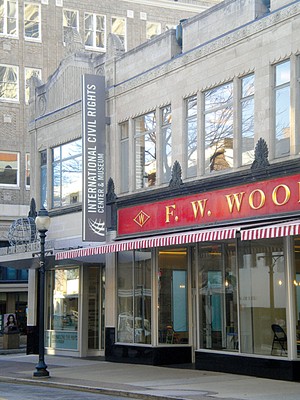Greensboro Civil Rights Museum Celebrates Second Anniversary

The International Civil Rights Center & Museum and its supporters celebrated two years of operation and the 52nd anniversary of the beginning of the Greensboro sit-ins at a $100-per-head gala last week. The legacy of the sit-ins and the first years of the museum have given the community much to commemorate and celebrate, including steady attendance, increased programming and possible new funding sources and exhibits.
“It’s had an impact on people’s appreciation of the sacrifice people made to kill off Jim Crow and make us one America,” said co-founder and board vice chair Earl Jones. “We’ve educated folk that… you shouldn’t take for granted where we are and that rights must be guarded. I think it provides a psychological and emotional uplift for people.”
Attendance rates fell from approximately 75,000 visitors in 2010 to 65,000 last year, an unsurprising and relatively small decrease considering an initial attendance bump as people flocked to the museum soon after it opened, director Bamidele Demerson said.
Museum tours remain steady, as schools and churches in particular regularly send busloads of people to tour the museum’s permanent collection, and dozens of events every month draw visitors.
Jones said the economic downtown might have helped museum attendance rates.
“If you look at the trends for a depressed economy, people look for an outlet that’s low cost and enjoyable to get them away from some of their day-to-day problems,” he said. “It may have been neutral or even an asset [to the museum]. We don’t have anything to compare it to since the economy was tanked when we opened.”
The museum has dealt with the dismal economy by hiring part-time people — like tour guides — and others on a consultant basis, and has utilized volunteer community members to help deverlop programming, such as its education program advisory committee. Demerson and Jones would not say if any staff positions were cut or the number of employees and their hours were scaled back since the museum was opened, but Demerson said the museum has done some restructuring and reorganizing.
“This museum, like all other cultural institutions, has had to deal with the downturn in the economy,” he said. “We’ve had to deal with staffing in relation to that, and we’ve certainly been wise in doing so. The museum has been successful at operating within its budget.”
Demerson was initially hired as the curator and programming director, and while he continues to fill those roles, he also replaced Amelia Parker as the executive director as she shifted to focus on sustainability for the museum.
“I don’t know that their challenges are any different than any other nonprofit,” said Parker, who is now the coordinator for institutional advancement at Bennett College, adding that she wasn’t sure if the museum had made staffing changes to save money.
Jones said he and Skip Alston, who is the museum co-founder and board chair, along with chairman of the Guilford County Commission, are focused on raising money and increasing the utilization of the facility to the point where the museum has “financial sovereignty.”
“The goal is to become economically self-sufficient,” Jones said. “We hope to get the US Congress to establish a commemorative coin for the sit-in movement. The sales revenue would come to the museum: it’s estimated it could generate $12-15 million that would go towards an endowment.”
If the coins were produced and sold out quickly enough, there could be a second printing that could potentially generate $30 million for the museum in total, Jones said.
The amount of programming rose slightly from 2010 to 2011, with the museum offering a wide array of cultural events on current and historic topics, including story time for youth, documentary screenings and guest lectures.
In addition to the yearly Alston-Jones International Civil & Human Rights Award, named for the museum co-founders, Jones said a number of events over the past few years stick out in his mind, including a screening of the film FBI-KKK by UNCG associate professor of media studies Michael Frierson.
Demerson said programming and rotating exhibitions allow the museum to engage with many important issues, including a recent exhibit about Muslims in North Carolina by Todd Drake or a current one called Village Life in Rural Africa by Reginald Hodges. Soon the museum will host events related to hazing and a constitutional amendment about same-sex marriage, and in September, it will host a temporary exhibit about Jewish South African anti-apartheid activist Helen Suzman.
“As a museum we have to be a safe place for those discussions,” Demerson said. “I would match our programming with any cultural programming in this community. Whatever is current in the news, we’re dealing with that.”
Demerson hopes the museum can institute a joint center for human rights with some of the educational institutions in town, increase the number of visiting international speakers and start providing related internships.
In addition to the commemorative coins, Jones shared a handful of other hopes he has for the future of the museum, particularly the creation of a hall of civil rights leaders including robots of people like Rosa Parks and Harriet Tubman that would interact and increasing the museum’s exhibit coverage of international civil rights.
Jones estimated that only 10 percent of the museum’s permanent collection is internationally focused and said he hopes the amount can be increased to 25 percent. Demerson said some of the programming and changing exhibits help provide an international component, like the current one on rural village life in Africa.
Though the museum has been open for two years, Jones said he is still impressed.
“Once it was completed, just to see the awesomeness of it was overwhelming,” he said. “Even a little bit for me now, it’s stunning.”

